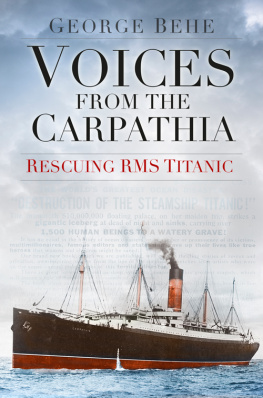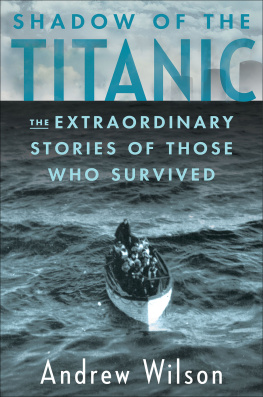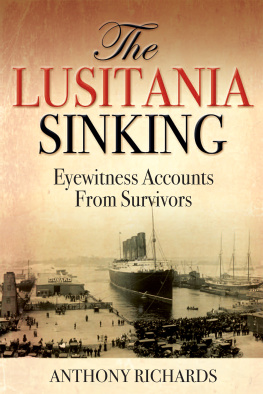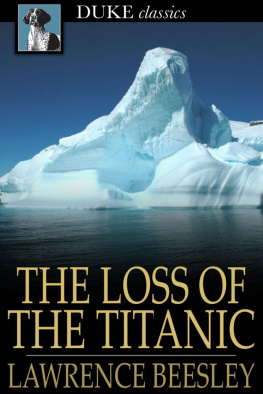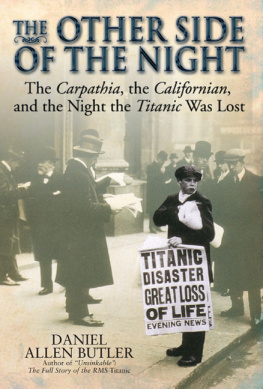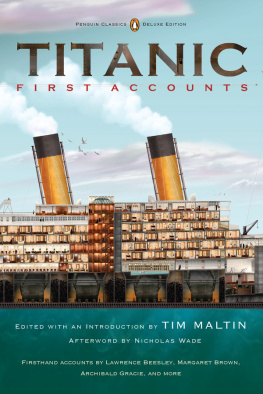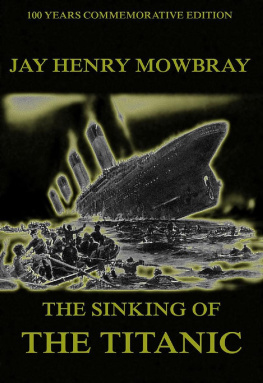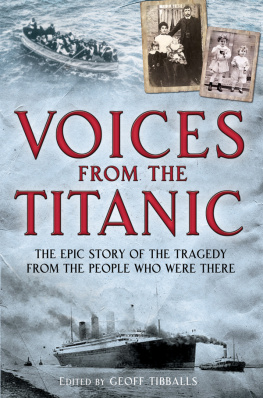
For my wife Pat
Although the majority of the material in this book has been culled from the authors own files, a considerable number of people and institutions generously provided me with the texts of additional documents that I might otherwise never have seen.
First and foremost, I would like to thank Ed and Karen Kamuda and the Titanic Historical Society and Titanic Museum for granting me permission to reproduce a number of rare documents that were published in back issues of the societys journal, the Commutator . As always, Don Lynch came through for me by sharing a number of rare documents from his personal collection. Kalman Tanito generously translated several rare accounts that were originally published in Hungary. Craig Sopin kindly provided me with the texts of several rare documents from his personal collection, and Randy Bryan Bigham unhesitatingly shared transcriptions of a number of documents that he uncovered during his own research. Malcolm Cheape was incredibly kind in providing me with the texts of hundreds of documents from the family archive of Joseph Bruce Ismay, and Jim Harper went above and beyond the call of duty in transcribing the texts of numerous original documents from the Frank Blackmarr scrapbooks.
Other individuals were equally kind in making the texts of unique documents available to me, and, so as not to show apparent favouritism to one person at the expense of another, Im forced to list these people in alphabetical order: Virginia Birt Baker, Richard M. Barbour, David Billnitzer, Patrick Bogue of Onslows, the family of Roger Bricoux, Muffet Brown, Shelley Dziedzic, Gordon Gardiner, Kristen Iversen, John Lamoreau, Anita Leslie, Olivier Mendez, Beverly Anne Mitchell, Charles and Lee Ann Otter, Tony Probst, Steve Rigby, Helen Ryder, Steve Santini, Eric Sauder, Les St Clair, Richard Stead, Craig Stringer, Geoffrey Ward, Gladys Weaver, Joan Webb, Ed Weichsler, Mrs Lawrence Grant White, Geoff Whitfield and Bill Wormstedt.
A number of institutions and archives were equally generous in sharing the texts of documents from their collections: the Franklin Delano Roosevelt Library, Library of Congress, Maritime Museum of the Atlantic, Blunt White Library, British Titanic Society, Fishburn Archives at Park University, Marconi Company Limited, National Archives, National Maritime Museum, Public Archives of Nova Scotia, Naval Historical Center, Royal Mail Streamline, Smithsonian Archives of American Art, Society of Professional Journalists, Straus Historical Society and the State Historical Society of Wisconsin.
To all of these individuals and institutions I offer my sincere thanks.
C ONTENTS
When the White Star liner Titanic began sending out distress calls after striking an iceberg in April 1912, one of the first vessels to reply to those distress calls was the Cunard liner Carpathia . As it turned out, Carpathia was the only vessel that reached the scene of the disaster in time to save the lives of any of Titanic s passengers and crewmen, and after she arrived in New York, newspaper reporters crowded the Cunard pier and vied with each other to obtain detailed first-hand interviews with the survivors of the disaster. In their zeal to interview Titanic survivors, though, the reporters often brushed right past other people who could have provided their own eyewitness accounts of the Titanic rescue Carpathia s own passengers.
Although there were occasional exceptions to the rule, the Carpathia s passengers and crewmen were usually left to their own devices as to how and when they discussed their own participation in the aftermath of the worlds greatest maritime disaster. A few Carpathia passengers wrote letters to relatives describing the things they had witnessed during the Titanic rescue, and a few others wrote accounts that were specifically intended for publication. Although the number of such first-hand accounts that have come to light since 1912 has been relatively small, one advantage of this fact is that the present author has been able to collect the texts of most of these documents and reproduce them in a single volume the volume you are holding in your hands. For the most part, these first-hand accounts have never been utilised in telling the story of the Titanic , and they are being offered here as a new source of information for future historians of the disaster.
In a similar vein, the number of Carpathia passengers who were interviewed by newspaper reporters in 1912 was so small that the present author has been able to gather together the vast majority of these interviews and present them here for the readers perusal. Even though these newspaper interviews are second-hand accounts whose reliability cannot be regarded with the same level of confidence as first-hand letters and memoirs, the interviews nevertheless assume importance as being the only surviving record of the experiences of many of those people on the Carpathia who witnessed the rescue of the Titanic s passengers.
In reading this collection of letters and interviews, historians will soon discover that not every word of these accounts can be accepted as gospel, since some of the documents contain information that was undoubtedly obtained second-hand on board the Carpathia . Even so, the documents contain enough solid facts to make them a valuable supplement to the existing body of evidence surrounding the Titanic disaster, and experienced researchers will easily recognise many Titanic passengers who remain unnamed in the documents themselves but whose described experiences in the disaster are well known.
While searching for accounts written by and about Carpathia passengers, the present author also ran across the texts of a number of interesting letters and accounts that were written by people on board other vessels that had a more distant connection with the Titanic disaster. It is hoped that these accounts will shed additional light on the tragic way the lives of many peripheral people were impacted by the loss of the largest passenger liner in the world.
The author hopes that the present volume will serve as a useful sourcebook of brand new information about the Titanic disaster.
George Behe
Mount Clemens, Michigan
C ARPATHIA P ASSENGER AND
C REW L ET TERS
J OHN B ADENOCH
On 18 April, while the Carpathia was approaching New York, Mr Badenoch sent the following Marconigram to Percy Straus, the son of victims Mr and Mrs Isidor Straus:
Every boat watched. Father and mother not on the Carpathia .
Badenoch
After interviewing multiple Titanic survivors regarding the fate of Mr and Mr Isidor Straus, Mr Badenoch dictated the following account to a reporter after arriving in New York:
Mr. and Mrs. Straus, when the crash came, immediately appeared in the companionway and inquired about the danger. They were reassured by one of the officers as well as by several of the other passengers that there was practically no danger and were advised to go back to their stateroom at that time and took the precaution of putting on extra clothing.
Mr. Straus insisted on their maid dressing to the fullest extent, wearing the heaviest clothing that she had. They again went on deck and were again reassured by an officer that there was no danger, but that they were going to take the precaution of lowering the boats for the women and children should something unforeseen happen.
They chatted on deck for some time after that discussing the possibility of the outcome resulting seriously. At this time several of the passengers impressed upon Mr. Straus the necessity of putting on life belts.
Next page
